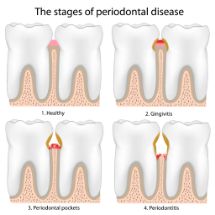 Did you know that gum disease affects approximately half of the U.S. population? Unfortunately, this common condition is the leading cause of tooth loss. Not to mention that it’s been found to increase the risk of many other diseases such as heart disease, diabetes, stroke, Alzheimer’s, and even some cancers. Since February is Gum Disease Awareness Month, it’s a perfect time to learn about 4 signs and symptoms of gum disease in Greensboro, (including one that might surprise you), as well as what treatment options are available. Learn more below!
Did you know that gum disease affects approximately half of the U.S. population? Unfortunately, this common condition is the leading cause of tooth loss. Not to mention that it’s been found to increase the risk of many other diseases such as heart disease, diabetes, stroke, Alzheimer’s, and even some cancers. Since February is Gum Disease Awareness Month, it’s a perfect time to learn about 4 signs and symptoms of gum disease in Greensboro, (including one that might surprise you), as well as what treatment options are available. Learn more below!
What Are the Symptoms of Gum Disease?
Gum disease (also called periodontal disease) is actually a “silent disease” because it isn’t painful until later stages. That’s why it’s even more important to keep an eye out for any of the following 4 symptoms:
- Bleeding gums- The earliest stage of gum disease (called gingivitis) often shows up as bleeding gums. With regular checkups and good oral hygiene, gingivitis can usually be reversed.
- Chronic bad breath – If gingivitis isn’t treated in time, it can progress to later stages of gum disease where odor-causing bacteria accumulate deep under the gumline.
- Gum recession or deep pocketing – In healthy gums, the gumline covers the entire root and the natural “pockets” of gum tissue around the teeth are only 1-3 mm. However, one sign of gum disease is recession, which can lead to sensitive teeth or pain when chewing. Deep pocket readings at your checkups (4mm and above) are also a sign.
- High blood sugar – This is one symptom that surprises many people, but researchers have found that there’s a link between high blood sugar (and/or diabetes) and gum disease.
Advanced gum disease can’t be reversed or cured, but there are treatments that can keep it from progressing.
How Is Gum Disease Treated?
The first step is getting a diagnosis, which is as easy as scheduling regular checkups. These visits include an annual evaluation so that gum disease can be found and treated as early as possible.
After a patient has been diagnosed, the first treatment for periodontal disease is a procedure called scaling and root planing (also called a “deep cleaning”). This special type of cleaning removes the plaque, tartar and bacteria from under the gumline that causes gum disease.
After the areas under the gumline are thoroughly cleaned, the roots of the teeth are smoothed to prevent bacteria from re-accumulating. This procedure is usually done in 2-4 appointments.
And, since good oral hygiene habits at home are incredibly important for managing gum disease, you’ll also get tips and tricks for maintaining your gum health in between visits.
Although gum disease has serious consequences, you can minimize your risk by identifying any symptoms right away and getting professional treatment early on!
About the Author
Dr. Shelly Pound is a family dentist and a graduate of the University of Kentucky College of Dentistry. She firmly believes that gum health is crucial for good oral and overall health, and always focuses on prevention and early treatment to help her patients prevent problems from the start. If you have any questions about gum disease in Greensboro, you can reach Dr. Pound via her website.
